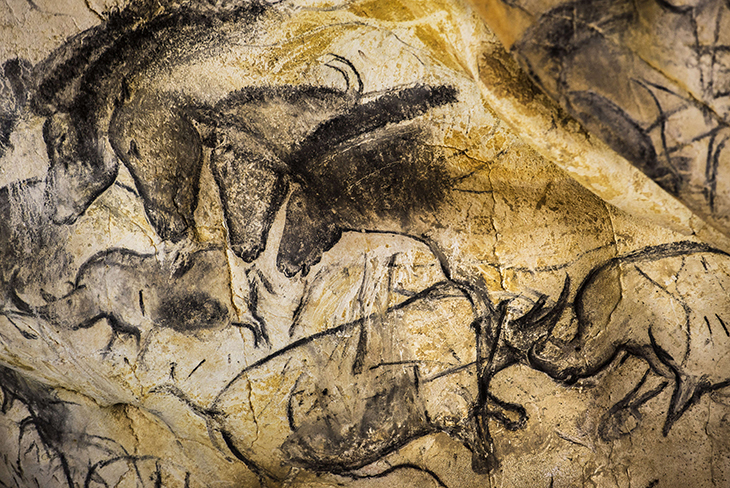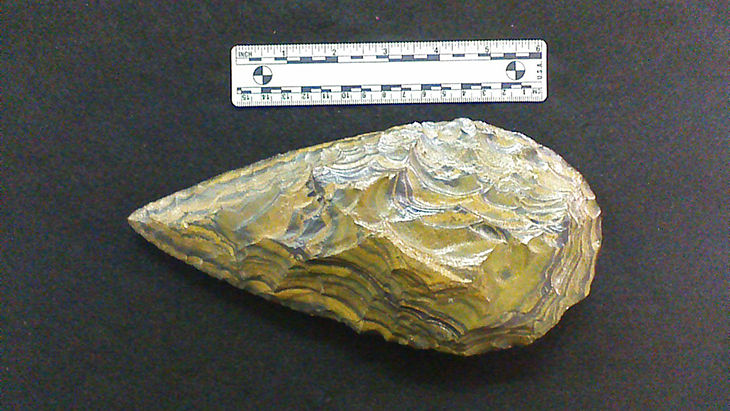Recently, archaeologists working at Blombos Cave in South Africa published a description of a 73,000-year-old artefact that now qualifies as the oldest confirmed example of drawing. The artefact is a small fragment (39 x 13 x 15mm) of a silcrete grinding stone on which someone had drawn a cross-hatched pattern of intersecting lines using a pointed ‘pencil’ of ochre. Provenance and dating of the artefact are secure. It is almost certainly what the authors purport it to be – the fragment of an intentionally drawn geometric pattern. The authors of the article in Nature further note that the pattern is similar to cross-hatched engravings from the same site, and that it was likely to have been an abstract symbol. Others have run with this particular assertion to make even more provocative claims about the origin of art, including an editorial column in the same issue of Nature that compares it to works of Piet Mondrian, Jackson Pollock and Bridget Riley.
Is all of this excitement warranted? Is this modestly adorned stone flake important evidence for the origin of art, and more specifically abstract art? Art history courses often begin their survey of art with the spectacular prehistoric painted caves of southern France and northern Spain, the oldest dated example of which, Chauvet Cave, may be close to 40,000 years old. The paintings are naturalistic depictions of animals, and in some caves also geometric patterns of lines and dots. The paintings demonstrate remarkable skill and confidence, and scholars have long thought that they could not be the very first drawings; there must have been antecedents. Thus the excitement over the Blombos drawings – 30,000 years earlier and a continent away.

Paintings of animal figures on the rock walls of the Chauvet cave, France, in 2014. Photo: Jeff Pachoud/AFP/Getty Images
However, when compared to the paintings of Chauvet, the Blombos evidence certainly seems impoverished. Something is missing, and this lacuna must bear somehow on the evolution of drawing, and perhaps art in general. What is the missing component? Answering this question requires a coherent perspective on the nature of art and aesthetic experience. The perspective that artist Tony Berlant and I have found most fruitful – explored in the museum exhibition and catalogue ‘First Sculpture: Handaxe to Figure Stone’ – is that of neuroaesthetics.
Neuroaesthetics is a research specialty that studies the cognitive and neurological basis of aesthetic experience using cognitive testing and neural imaging techniques. There is now general agreement in neuroaesthetics that several distinct but overlapping neural networks activate in an aesthetic experience (there are no aesthetic neurons per se) – a perceptual component, a pleasure-reward component, an evaluative component (like-dislike), and a cultural meaning component (socially acquired, often symbolic, occasionally abstract). Without bogging ourselves down in definitions of art, we can ask whether a particular example required all of these neural resources, or only a subset. The Chauvet paintings appear to have required all of them; this is why we find them so provocative. Even though we do not know what the images meant, we know that they meant something, and that a rich symbolic milieu lay behind them.
What about the Blombos drawings? In recent years archaeologist Derek Hodgson has examined the Blombos geometric engravings from a neuroaesthetic perspective and reached a different but equally interesting interpretation. When the visual cortex of the brain detects certain geometric patterns such as cross-hatching, it sends signals to pleasure-producing neurons eliciting a corresponding response. Some geometric patterns are just pleasing to look at. And, given that someone chose to decorate objects with this pattern, an element of evaluation was also in play. However – and this is the important point – cultural meaning was not required. In other words, the fourth component of aesthetic experience, symbolic meaning, is missing. It is of course possible that the patterns had meaning, it is just not necessary – and in any evolutionary interpretation one must always favour the simplest explanation.

600,000-year-old iron stone handaxe from Kathu Pan, South Africa. Photo: the author
The Blombos drawing and engravings are not entirely mute concerning the evolution of aesthetic experience. They corroborate other varieties of evidence, including the 300,000-year-old record of pigment use, and the 1.5 million-year-old record of imposing symmetry on tools. Our ancestors exploited visual effects for the pleasure they gave long before they imbued artefacts with symbolic meaning. In this regard the Blombos drawing marks a final chapter in a long evolutionary story, not the beginning of a new one.
Thomas Wynn is Professor of Anthropology at the University of Colorado, Colorado Springs. He co-curated the exhibition ‘First Sculpture: Handaxe to Figure Stone’ at the Nasher Sculpture Center, Dallas in 2018.

The oldest drawing in the world has been discovered – but is it art?
The drawing found in Blombos Cave, South Africa. Photo: Craig Foster/University of Bergen/Nature
Share
Recently, archaeologists working at Blombos Cave in South Africa published a description of a 73,000-year-old artefact that now qualifies as the oldest confirmed example of drawing. The artefact is a small fragment (39 x 13 x 15mm) of a silcrete grinding stone on which someone had drawn a cross-hatched pattern of intersecting lines using a pointed ‘pencil’ of ochre. Provenance and dating of the artefact are secure. It is almost certainly what the authors purport it to be – the fragment of an intentionally drawn geometric pattern. The authors of the article in Nature further note that the pattern is similar to cross-hatched engravings from the same site, and that it was likely to have been an abstract symbol. Others have run with this particular assertion to make even more provocative claims about the origin of art, including an editorial column in the same issue of Nature that compares it to works of Piet Mondrian, Jackson Pollock and Bridget Riley.
Is all of this excitement warranted? Is this modestly adorned stone flake important evidence for the origin of art, and more specifically abstract art? Art history courses often begin their survey of art with the spectacular prehistoric painted caves of southern France and northern Spain, the oldest dated example of which, Chauvet Cave, may be close to 40,000 years old. The paintings are naturalistic depictions of animals, and in some caves also geometric patterns of lines and dots. The paintings demonstrate remarkable skill and confidence, and scholars have long thought that they could not be the very first drawings; there must have been antecedents. Thus the excitement over the Blombos drawings – 30,000 years earlier and a continent away.
Paintings of animal figures on the rock walls of the Chauvet cave, France, in 2014. Photo: Jeff Pachoud/AFP/Getty Images
However, when compared to the paintings of Chauvet, the Blombos evidence certainly seems impoverished. Something is missing, and this lacuna must bear somehow on the evolution of drawing, and perhaps art in general. What is the missing component? Answering this question requires a coherent perspective on the nature of art and aesthetic experience. The perspective that artist Tony Berlant and I have found most fruitful – explored in the museum exhibition and catalogue ‘First Sculpture: Handaxe to Figure Stone’ – is that of neuroaesthetics.
Neuroaesthetics is a research specialty that studies the cognitive and neurological basis of aesthetic experience using cognitive testing and neural imaging techniques. There is now general agreement in neuroaesthetics that several distinct but overlapping neural networks activate in an aesthetic experience (there are no aesthetic neurons per se) – a perceptual component, a pleasure-reward component, an evaluative component (like-dislike), and a cultural meaning component (socially acquired, often symbolic, occasionally abstract). Without bogging ourselves down in definitions of art, we can ask whether a particular example required all of these neural resources, or only a subset. The Chauvet paintings appear to have required all of them; this is why we find them so provocative. Even though we do not know what the images meant, we know that they meant something, and that a rich symbolic milieu lay behind them.
What about the Blombos drawings? In recent years archaeologist Derek Hodgson has examined the Blombos geometric engravings from a neuroaesthetic perspective and reached a different but equally interesting interpretation. When the visual cortex of the brain detects certain geometric patterns such as cross-hatching, it sends signals to pleasure-producing neurons eliciting a corresponding response. Some geometric patterns are just pleasing to look at. And, given that someone chose to decorate objects with this pattern, an element of evaluation was also in play. However – and this is the important point – cultural meaning was not required. In other words, the fourth component of aesthetic experience, symbolic meaning, is missing. It is of course possible that the patterns had meaning, it is just not necessary – and in any evolutionary interpretation one must always favour the simplest explanation.
600,000-year-old iron stone handaxe from Kathu Pan, South Africa. Photo: the author
The Blombos drawing and engravings are not entirely mute concerning the evolution of aesthetic experience. They corroborate other varieties of evidence, including the 300,000-year-old record of pigment use, and the 1.5 million-year-old record of imposing symmetry on tools. Our ancestors exploited visual effects for the pleasure they gave long before they imbued artefacts with symbolic meaning. In this regard the Blombos drawing marks a final chapter in a long evolutionary story, not the beginning of a new one.
Thomas Wynn is Professor of Anthropology at the University of Colorado, Colorado Springs. He co-curated the exhibition ‘First Sculpture: Handaxe to Figure Stone’ at the Nasher Sculpture Center, Dallas in 2018.
Unlimited access from just $16 every 3 months
Subscribe to get unlimited and exclusive access to the top art stories, interviews and exhibition reviews.
Share
Recommended for you
What’s at stake in digitising heritage sites such as the Lascaux cave?
A new facsimile of the Lascaux cave is about to open, but are digital reproductions of cultural sites merely tourist attractions or will they save our fragile heritage?
The kingdom built on frankincense and myrrh
A $20 billion project to transform Saudi Arabia’s al-Ula region has brought attention to a little-known ancient site
Dinosaurs, dioramas, and the strange world of natural history
Paleoart and dioramas are designed to depict prehistory and the natural world – but what they really reveal are our own hopes and fears